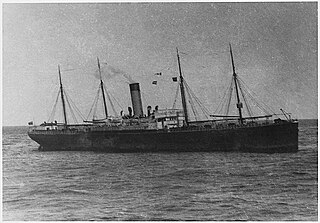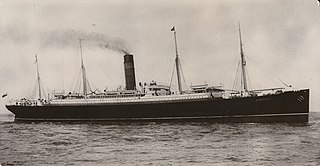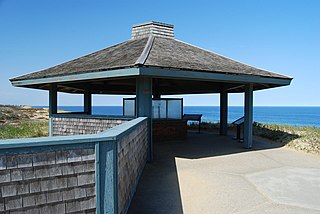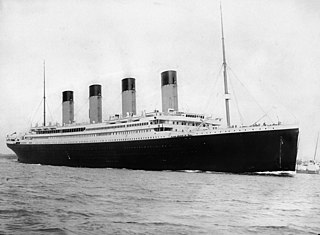
SOS is a Morse code distress signal, used internationally, originally established for maritime use. In formal notation SOS is written with an overscore line, to indicate that the Morse code equivalents for the individual letters of "SOS" are transmitted as an unbroken sequence of three dots / three dashes / three dots, with no spaces between the letters. In International Morse Code three dots form the letter "S" and three dashes make the letter "O", so "S O S" became a common way to remember the order of the dots and dashes. IWB, VZE, 3B, and V7 form equivalent sequences, but traditionally SOS is the easiest to remember.
CQD is one of the first distress signals adopted for radio use. On 7 January 1904 the Marconi International Marine Communication Company issued "Circular 57", which specified that, for the company's installations, beginning 1 February 1904 "the call to be given by ships in distress or in any way requiring assistance shall be 'C Q D' ".

SS Californian was a British Leyland Line steamship. She is thought to have been the only ship in sight of the Titanic, or at least her rockets, during that ship's sinking. The crew took no action to assist.

John George "Jack" Phillips was a British sailor and the senior wireless operator aboard the Titanic during her ill-fated maiden voyage in April 1912.

Harold Sydney Bride was a British merchant seaman and the junior wireless operator on the ocean liner RMS Titanic during her ill-fated maiden voyage.

RMS Republic was a steam-powered ocean liner built in 1903 by Harland and Wolff in Belfast, and lost at sea in a collision in 1909 while sailing for the White Star Line. The ship was equipped with a new Marconi wireless telegraphy transmitter, and issued a CQD distress call, resulting in the saving of around 1,500 lives. Known as the "Millionaires' Ship" because of the number of wealthy Americans who traveled by her, she was described as a "palatial liner" and was the flagship of White Star Line's Boston service. This was the first important marine rescue made possible by radio, and brought worldwide attention to this new technology.
Captain Joseph Barlow Ranson was a British sea captain and commander of White Star Line liners. He is notable for his role in the rescue of the passengers of the RMS Republic in 1909 using wireless technology, the first marine rescue made possible by radio. In 1912, he was captain of the ship that contacted the ill-fated RMS Titanic to report the sighting of icebergs.

Harold Thomas Cottam was a British wireless operator on the RMS Carpathia who fortuitously happened to receive the distress call from the sinking RMS Titanic on 15 April 1912. Cottam's decision to awaken Captain Arthur Henry Rostron and relay Titanic's message in spite of the scepticism of the officer on watch allowed Carpathia to arrive at the scene hours before any other ship and is "credited with saving hundreds of lives." He was a personal friend of the Titanic's wireless operators Harold Bride and Jack Phillips.
Admiralty House is a one-storey, wooden gable-roofed, municipally-designated heritage building originally built as a wireless communications station in Mount Pearl, Newfoundland and Labrador, Canada. It currently serves as a museum and archives. The building is purported to be the last standing of 11 such identical stations built around the world during the First World War.

RMS Titanic sank on 15 April 1912 in the North Atlantic Ocean. The largest ocean liner in service at the time, Titanic was four days into her maiden voyage from Southampton, England, to New York City, with an estimated 2,224 people on board when she struck an iceberg at 23:40 on 14 April. Her sinking two hours and forty minutes later at 02:20 ship's time on 15 April resulted in the deaths of more than 1,500 people, making it one of the deadliest peacetime maritime disasters in history.

RMS Carpathia was a Cunard Line transatlantic passenger steamship built by Swan Hunter & Wigham Richardson in their shipyard in Wallsend, England.

The Marconi Wireless Station Site in South Wellfleet, Massachusetts, USA is the site of the first transatlantic wireless communication between the United States of America and Europe, on January 18, 1903. At this location, now part of the Cape Cod National Seashore, inventor Guglielmo Marconi erected a large antenna array on four 210-foot (64 m) wooden towers, and established a transmitting station powered by kerosene engines that produced the 25,000 volts of electricity needed to send signals to a similar station in Poldhu, Cornwall, United Kingdom. The first transmission received on the continent of North America by Marconi was at Signal Hill, St. John's, Newfoundland and Labrador in 1901; Glace Bay, Nova Scotia was the site of the first such two-way transmission, in 1902.

RMS Titanic was a British ocean liner that sank in the early hours of 15 April 1912 as a result of striking an iceberg on her maiden voyage from Southampton, England, to New York City, United States. Being the second time White Star Line has lost a ship on its maiden voyage. The other, being the RMS Tayleur of 1854. Of the estimated 2,224 passengers and crew aboard, approximately 1,500 died, making the incident one of the deadliest peacetime sinkings of a single ship. Titanic, operated by the White Star Line, carried some of the wealthiest people in the world, as well as hundreds of emigrants from the British Isles, Scandinavia, and elsewhere in Europe who were seeking a new life in the United States and Canada. The disaster drew public attention, spurred major changes in maritime safety regulations, and inspired a lasting legacy in popular culture.

There have been several legends and myths surrounding the RMS Titanic and its destruction after colliding with an iceberg in the Atlantic Ocean. These have ranged from stories involving the myth about the ship having been described as "unsinkable" to the myth concerning the final song played by the ship's musicians.

The sinking of the RMS Titanic on April 14–15, 1912 resulted in an inquiry by a subcommittee of the Commerce Committee of the United States Senate, chaired by Senator William Alden Smith. The hearings began in New York on April 19, 1912, later moving to Washington, D.C., concluding on May 25, 1912 with a return visit to New York.
The ocean liner Titanic has been extensively portrayed in films, books, memorials and museums.

Cape Race Lighthouse is an active lighthouse located at Cape Race on the Avalon Peninsula, Newfoundland. The light's characteristic is a single white flash every 7.5 seconds; additionally, a foghorn may sound a signal of two blasts every 60 seconds. It is located on one of Canada's busiest shipping lanes. The lighthouse is also a tourist attraction.

SS Grampian was a transatlantic ocean liner that was built in Scotland in 1907 and scrapped in the Netherlands in 1925. She was operated originally by Allan Line, and later by Canadian Pacific Steamships. In the First World War she remained in commercial service but carried Canadian troops. In 1919 she survived a collision with an iceberg. In 1921 she was gutted by fire while being refitted. The refit was abandoned, and in 1925–26 she was scrapped.

SS Birma was a British-built transatlantic passenger ship. She was built in 1894 by Fairfield Shipbuilding and Engineering Company in Govan, United Kingdom, as Arundel Castle and later went through numerous ownership and name changes, including coming into the hands of the Russian American Line. In 1912, Birma was one of the ships to respond to the sinking of RMS Titanic. She was broken up in 1924 following acquisition by a German line after a liquidation sale.

















